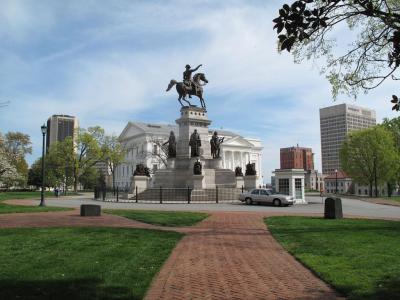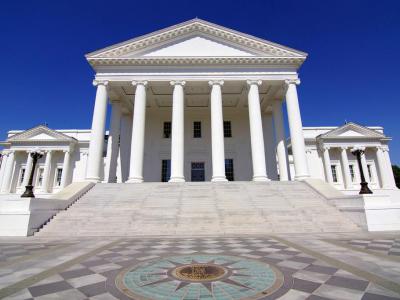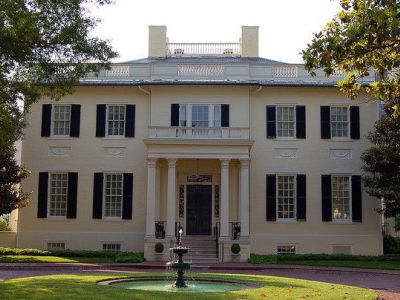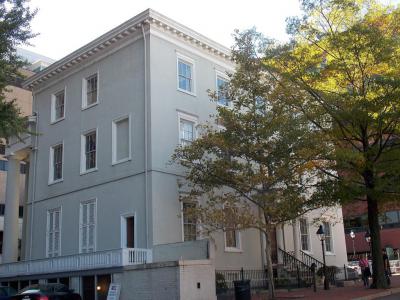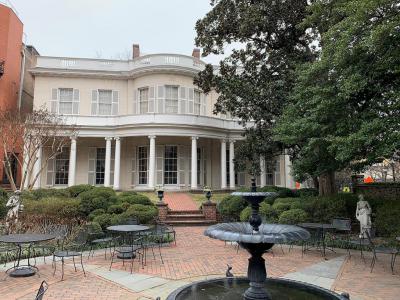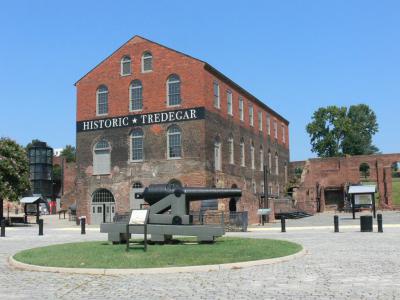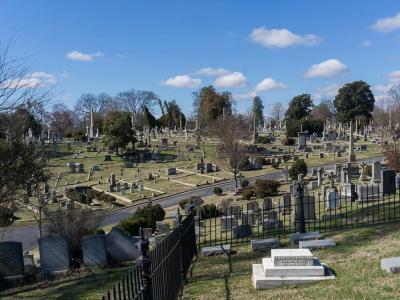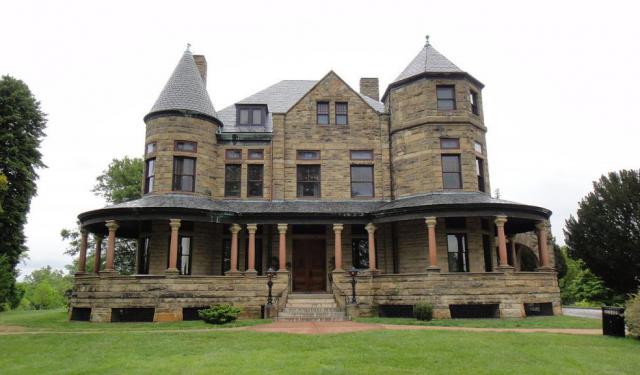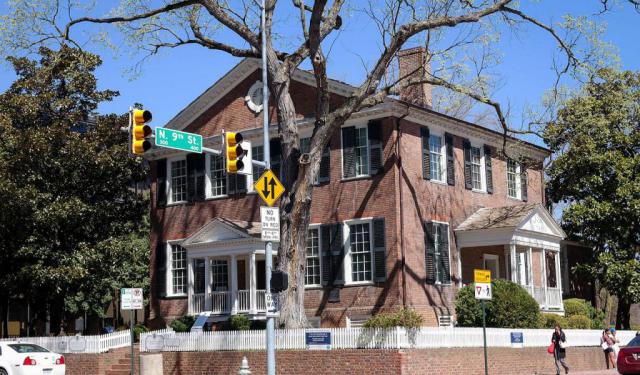Richmond Introduction Walking Tour (Self Guided), Richmond
After settling Jamestown in 1607, several expeditions up the James River led to an interest in the area inhabited by the Powhatan Nation. But the first European settlements didn’t come for more than a hundred years when in 1737, planter William Byrd II had the original town grid laid out.
He named the town “Richmond” after an English town. He felt the view of the James River was similar to the view of the River Thames from Richmond Hill, near London. It was incorporated in 1742.
The town had a starring role in nearly all early US events. Patrick Henry gave his famous “Give Me Liberty or Give Me Death” speech here in 1775. The city was attacked and burned by the British during the Revolutionary War in 1781, forcing then-Governor Thomas Jefferson to flee.
But the city recovered quickly afterward, and Jefferson designed a new capitol building. It’s a beautiful structure that is used to this day as the capitol of the Commonwealth of Virginia. Standing in the center of Capitol Square, it is a must-see sight in Richmond.
Richmond again played a pivotal role in the American Civil War as the capital of the Confederacy. The American Civil War Museum and the White House of the Confederacy are great stops to learn more about this period in Richmond’s past.
Today the city is a vibrant river-front town with lots of history to explore and things to do. Don’t miss Carytown, a boutique shopping and dining experience, along with the restored Byrd Theater, a 1920’s movie palace. Nearby Byrd Park is a great place to walk and enjoy the view of the James River, as is the neighboring Maymont estate and gardens. If you love history, don’t miss The Valentine, Richmond’s oldest museum, or the Hollywood Cemetery, where thousands of Civil War-era soldiers and several US presidents lie in rest.
Richmond has something for everyone, so put on your walking shoes and take a tour of this beautiful city.
He named the town “Richmond” after an English town. He felt the view of the James River was similar to the view of the River Thames from Richmond Hill, near London. It was incorporated in 1742.
The town had a starring role in nearly all early US events. Patrick Henry gave his famous “Give Me Liberty or Give Me Death” speech here in 1775. The city was attacked and burned by the British during the Revolutionary War in 1781, forcing then-Governor Thomas Jefferson to flee.
But the city recovered quickly afterward, and Jefferson designed a new capitol building. It’s a beautiful structure that is used to this day as the capitol of the Commonwealth of Virginia. Standing in the center of Capitol Square, it is a must-see sight in Richmond.
Richmond again played a pivotal role in the American Civil War as the capital of the Confederacy. The American Civil War Museum and the White House of the Confederacy are great stops to learn more about this period in Richmond’s past.
Today the city is a vibrant river-front town with lots of history to explore and things to do. Don’t miss Carytown, a boutique shopping and dining experience, along with the restored Byrd Theater, a 1920’s movie palace. Nearby Byrd Park is a great place to walk and enjoy the view of the James River, as is the neighboring Maymont estate and gardens. If you love history, don’t miss The Valentine, Richmond’s oldest museum, or the Hollywood Cemetery, where thousands of Civil War-era soldiers and several US presidents lie in rest.
Richmond has something for everyone, so put on your walking shoes and take a tour of this beautiful city.
How it works: Download the app "GPSmyCity: Walks in 1K+ Cities" from Apple App Store or Google Play Store to your mobile phone or tablet. The app turns your mobile device into a personal tour guide and its built-in GPS navigation functions guide you from one tour stop to next. The app works offline, so no data plan is needed when traveling abroad.
Richmond Introduction Walking Tour Map
Guide Name: Richmond Introduction Walking Tour
Guide Location: USA » Richmond (See other walking tours in Richmond)
Guide Type: Self-guided Walking Tour (Sightseeing)
# of Attractions: 7
Tour Duration: 2 Hour(s)
Travel Distance: 3.7 Km or 2.3 Miles
Author: damon
Sight(s) Featured in This Guide:
Guide Location: USA » Richmond (See other walking tours in Richmond)
Guide Type: Self-guided Walking Tour (Sightseeing)
# of Attractions: 7
Tour Duration: 2 Hour(s)
Travel Distance: 3.7 Km or 2.3 Miles
Author: damon
Sight(s) Featured in This Guide:
- Capitol Square
- Virginia State Capitol Building
- Governor's Mansion
- White House of the Confederacy
- The Valentine
- Tredegar Iron Works and American Civil War Museum
- Hollywood Cemetery
1) Capitol Square
The area in the center of Richmond that surrounds the Virginia Capitol Building is known as Capitol Square. The Square is roughly bounded between Broad and Bank Streets and Ninth and Governors Streets. Besides being the center of the Commonwealth's governance, the square contains several monuments to prominent Virginians. The Square encompasses roughly 12 acres and is bounded by one of the oldest wrought iron fences in the country, installed in 1818.
The most notable monument is the George Washington Equestrian statue, built in 1858 by Jean-Antoine Houdon. It's a life-size marble statue of Washington atop a horse; you can't miss it. Patrick Henry, Thomas Jefferson, "Stonewall" Jackson, and many other notable Virginians are commemorated in the plaza. The bell tower was built in 1825 for the Virginia Public Gaurd. It is used each day to call the General Assembly into session. There is also a Virginia Civil Rights Memorial, built in 2008, and Voices from the Garden-The Virginia Women's Monument, which was begun in 2018. Adjacent to the Capitol Building is the Executive Mansion, where the governor resides. There are also several departmental headquarters.
When visiting Capitol Square, start your tour at the Capitol Visitors Center off of Bank Street. When you include all of the public buildings and outdoor spaces, Capitol Square contains more than 130 pieces of artwork, from paintings to sculptures. The Square is one of the oldest planned parks in the country, older than Central Park in New York. It was laid out and designed by Maximilian Godefroy in 1816 with geometric precision reminiscent of 18th-century French courtyards. It was further developed in 1850 in the picturesque English style; the result is a modern-day green space that is a pleasure to stroll around and is a central part of the Commonwealth's political and social heart.
The most notable monument is the George Washington Equestrian statue, built in 1858 by Jean-Antoine Houdon. It's a life-size marble statue of Washington atop a horse; you can't miss it. Patrick Henry, Thomas Jefferson, "Stonewall" Jackson, and many other notable Virginians are commemorated in the plaza. The bell tower was built in 1825 for the Virginia Public Gaurd. It is used each day to call the General Assembly into session. There is also a Virginia Civil Rights Memorial, built in 2008, and Voices from the Garden-The Virginia Women's Monument, which was begun in 2018. Adjacent to the Capitol Building is the Executive Mansion, where the governor resides. There are also several departmental headquarters.
When visiting Capitol Square, start your tour at the Capitol Visitors Center off of Bank Street. When you include all of the public buildings and outdoor spaces, Capitol Square contains more than 130 pieces of artwork, from paintings to sculptures. The Square is one of the oldest planned parks in the country, older than Central Park in New York. It was laid out and designed by Maximilian Godefroy in 1816 with geometric precision reminiscent of 18th-century French courtyards. It was further developed in 1850 in the picturesque English style; the result is a modern-day green space that is a pleasure to stroll around and is a central part of the Commonwealth's political and social heart.
2) Virginia State Capitol Building (must see)
Only two state capitol buildings in the US were designed to recreate ancient world architecture. In Vermont, the State House has elements based on Athens' Temple of Hephaestus. The Virginia State Capitol Building's design was credited to none other than Thomas Jefferson, who worked closely with architect Charles-Louis Clérisseau to recreate an ancient Roman temple from southern France, Maison Carrée at Nîmes. It was the first modern building in the New World to be designed based on a classical Roman temple. It was also the first state capitol building built in the US after the Revolutionary War. A statue of Jefferson stands in the plaza of the Capitol Extension.
The building was completed in 1788, with the first General Assembly meeting held inside the building in 1792. During the Civil War, the building also served as the capitol building of the Confederacy. The building has been renovated several times in its history, with the most significant changes occurring in 1904 when two large wings were built to allow space for the growing assembly. When even more space was needed, a considerable expansion project was commenced underground to preserve Jefferson's original building's beauty. The 2007 project added 27,000 square feet of space and cost $104.5 million.
Why You Should Visit:
The Virginia State Capitol building is one of the most beautiful and unique state capitols. The design, chosen by Thomas Jefferson, was drawn from a plaster model he had made of the first-century Roman temple in France.
The building itself was featured in a national TV documentary and named one of the "10 buildings that changed America." If you're interested in history, architecture, or government, this tour is a must-see.
The Capitol Building houses many portraits and artworks of famous Virginians. In the central Rotunda, you will find Jean-Antoine Houdon's marble statue of George Washington. This is the only statue made while Washington was alive. The 6'2" statue was considered to be a perfect likeness.
Tips:
You can tour the building on your own but plan on joining one of the free guided tours for the best experience. Guided tours include the Rotunda, the Old House and Old Senate chambers, and one of the 1906 legislative chambers. Group tours are available for parties of ten or more. Inquire at the Visitors Center for information about tours.
If your a fan of Virginia or just historic buildings, don't miss the Virginia Shop on your way out. Meriwether's Café offers made-to-order fresh food and takeout service if you get hungry.
The building was completed in 1788, with the first General Assembly meeting held inside the building in 1792. During the Civil War, the building also served as the capitol building of the Confederacy. The building has been renovated several times in its history, with the most significant changes occurring in 1904 when two large wings were built to allow space for the growing assembly. When even more space was needed, a considerable expansion project was commenced underground to preserve Jefferson's original building's beauty. The 2007 project added 27,000 square feet of space and cost $104.5 million.
Why You Should Visit:
The Virginia State Capitol building is one of the most beautiful and unique state capitols. The design, chosen by Thomas Jefferson, was drawn from a plaster model he had made of the first-century Roman temple in France.
The building itself was featured in a national TV documentary and named one of the "10 buildings that changed America." If you're interested in history, architecture, or government, this tour is a must-see.
The Capitol Building houses many portraits and artworks of famous Virginians. In the central Rotunda, you will find Jean-Antoine Houdon's marble statue of George Washington. This is the only statue made while Washington was alive. The 6'2" statue was considered to be a perfect likeness.
Tips:
You can tour the building on your own but plan on joining one of the free guided tours for the best experience. Guided tours include the Rotunda, the Old House and Old Senate chambers, and one of the 1906 legislative chambers. Group tours are available for parties of ten or more. Inquire at the Visitors Center for information about tours.
If your a fan of Virginia or just historic buildings, don't miss the Virginia Shop on your way out. Meriwether's Café offers made-to-order fresh food and takeout service if you get hungry.
3) Governor's Mansion
The Virginia Executive Mansion was built in 1813 and is the oldest governor's house in the nation that is still used for its intended purpose. Best of all, the mansion can be toured on a limited basis. For details, see the Capitol Visitors Center. Tours of the mansion are completed with docents in each room and last about 30 minutes. The current governor and his family do live here, so there is a chance you will see them out and about.
The home is a classic example of Federal-style architecture, designed by Alexander Parris. The house has been beautifully restored to appear as it did in the 1830s, but it not features more living space and is compliant with the Americans with Disabilities Act.
The house is full of history. Three US presidents have resided here at one time or another. Both Presidents Monroe and Tyler served as governor of the Commonwealth before their time in Washington, while William Henry Harrison lived there as the son of Benjamin Harrison. Interestingly, Governor Tim Kaine's wife, Anne Holton, lived in the mansion twice. She happens to be the daughter of former governor A. Linwood Holton Jr.
The gardens around the mansion are impressive too, and they host many events throughout the year. The house has made several appearances on popular TV over the years, including when Virginia First Lady Anne Holton hosted an American Idol finalist from Richmond and when Bob Vila featured the remodeling work on Home Again. Many distinguished visitors have stepped through this house's doors, including Queen Elizabeth II, many US presidents, and Charles Lindbergh. The home is a National Historic Landmark and is on the National Register of Historic Places.
The home is a classic example of Federal-style architecture, designed by Alexander Parris. The house has been beautifully restored to appear as it did in the 1830s, but it not features more living space and is compliant with the Americans with Disabilities Act.
The house is full of history. Three US presidents have resided here at one time or another. Both Presidents Monroe and Tyler served as governor of the Commonwealth before their time in Washington, while William Henry Harrison lived there as the son of Benjamin Harrison. Interestingly, Governor Tim Kaine's wife, Anne Holton, lived in the mansion twice. She happens to be the daughter of former governor A. Linwood Holton Jr.
The gardens around the mansion are impressive too, and they host many events throughout the year. The house has made several appearances on popular TV over the years, including when Virginia First Lady Anne Holton hosted an American Idol finalist from Richmond and when Bob Vila featured the remodeling work on Home Again. Many distinguished visitors have stepped through this house's doors, including Queen Elizabeth II, many US presidents, and Charles Lindbergh. The home is a National Historic Landmark and is on the National Register of Historic Places.
4) White House of the Confederacy (must see)
Tucked away in the Court End neighborhood not far from Capitol Square is the Jefferson Davis Executive Mansion. During the Civil War, the house was considered the Confederate States of America's counterpart to the White House in Washington, DC. Jefferson Davis was the sole president of the Confederacy, and he lived here from 1861 to 1865.
The house was built in 1818 and is a gray stucco mansion built in the neoclassical style. Robert Mills designed it for John Brockenbrough, president of the Bank of Virginia. Being so close to the State Capitol, the neighborhood was full of high-level politicians and wealthy townspeople. Brockenbrough sold in 1844, and the house changed hands several times. It was eventually sold to the city, who rented it to the Confederate government for use as the Executive Mansion.
The Jefferson family and their staff abandoned the house as Richmond was evacuated in 1865. The house was taken intact, and President Lincoln toured the home and held several meetings with local officials. Lincoln spent several hours touring the home, but he did not go beyond the downstairs floor as he felt doing so would be an invasion of privacy.
When the city announced that they planned to destroy the building in 1890, the Confederate Memorial Literary Society was formed to save the mansion. It became the Museum of the Confederacy for over 80 years. After a complete restoration in the 1980s that returned the entire structure to its wartime appearance, the building became known as the White House of the Confederacy and is part of the American Civil War Museum, which is located off-site. Today the house stands alone, surrounded by the VCU medical campus.
Why You Should Visit:
The house has been masterfully restored to appear as it did during wartime. The exhibit House of the Lost Cause explores the history of the Confederacy through Jefferson Davis and his daughter, Winnie Davis, with some of their personal items on display.
Tips:
Plan to spend about 45 minutes or so touring the mansion. Since you're visiting the area, consider combining this tour with a visit to The Valentine, Richmond's history museum.
The house was built in 1818 and is a gray stucco mansion built in the neoclassical style. Robert Mills designed it for John Brockenbrough, president of the Bank of Virginia. Being so close to the State Capitol, the neighborhood was full of high-level politicians and wealthy townspeople. Brockenbrough sold in 1844, and the house changed hands several times. It was eventually sold to the city, who rented it to the Confederate government for use as the Executive Mansion.
The Jefferson family and their staff abandoned the house as Richmond was evacuated in 1865. The house was taken intact, and President Lincoln toured the home and held several meetings with local officials. Lincoln spent several hours touring the home, but he did not go beyond the downstairs floor as he felt doing so would be an invasion of privacy.
When the city announced that they planned to destroy the building in 1890, the Confederate Memorial Literary Society was formed to save the mansion. It became the Museum of the Confederacy for over 80 years. After a complete restoration in the 1980s that returned the entire structure to its wartime appearance, the building became known as the White House of the Confederacy and is part of the American Civil War Museum, which is located off-site. Today the house stands alone, surrounded by the VCU medical campus.
Why You Should Visit:
The house has been masterfully restored to appear as it did during wartime. The exhibit House of the Lost Cause explores the history of the Confederacy through Jefferson Davis and his daughter, Winnie Davis, with some of their personal items on display.
Tips:
Plan to spend about 45 minutes or so touring the mansion. Since you're visiting the area, consider combining this tour with a visit to The Valentine, Richmond's history museum.
5) The Valentine
While many museums and attractions in the city focus on particular time periods, The Valentine is an attraction dedicated to preserving all of Richmond's history. It was the first private museum in town, established in 1898, and it includes the Wickham House. The museum was founded by Mann S. Valentine II, a wealthy entrepreneur who made his money selling a health tonic called Valentine's Meat Juice. Like many wealthy entrepreneurs of the Gilded Age, he became a collector. His interests spanned anthropology, archaeology, and the arts. He began creating a museum one year before his death, but the museum was completed and opened in 1898 per his wishes. Mann's brother Edward served as the museum's first president.
The museum's primary exhibition explores Richmond's history through personal stories and unique artifacts from The Valentine's massive collection. The museum also offers rotating exhibits, so check their website for their current showings. Previous exhibits have focused on big themes like the Great Depression in Richmond or small details like the gowns worn at inaugural balls by Virginia's first ladies.
The Wickham House was built in 1812 and is restored to how it would have appeared in the Antebellum period. Through a dialogue-based guided tour, you will learn the stories of the Wickham family and the home's enslaved occupants. The museum and the house are on the National Register of Historic Places.
The museum's primary exhibition explores Richmond's history through personal stories and unique artifacts from The Valentine's massive collection. The museum also offers rotating exhibits, so check their website for their current showings. Previous exhibits have focused on big themes like the Great Depression in Richmond or small details like the gowns worn at inaugural balls by Virginia's first ladies.
The Wickham House was built in 1812 and is restored to how it would have appeared in the Antebellum period. Through a dialogue-based guided tour, you will learn the stories of the Wickham family and the home's enslaved occupants. The museum and the house are on the National Register of Historic Places.
6) Tredegar Iron Works and American Civil War Museum (must see)
The American Civil War Museum in Richmond is a multi-site institution dedicated to preserving and interpreting the extensive history of the American Civil War. With its three locations-the White House of the Confederacy, the American Civil War Museum at Historic Tredegar in Richmond, and the American Civil War Museum at Appomattox-the museum presents a diverse collection and range of exhibits that delve deep into the war's complex narrative.
The Museum's origin dates back to 1894 with the establishment of the Museum of the Confederacy, located in the historic White House of the Confederacy. This site, close to the Virginia State Capitol, was preserved from destruction by the Ladies Hollywood Memorial Association and opened as a museum on the anniversary of Jefferson Davis's inauguration in 1896. It became a National Historic Landmark in 1963. The museum hosts an extensive collection of Confederate flags, weapons, documents, and personal belongings from key figures such as Jefferson Davis and Robert E. Lee.
In 2012, the American Civil War Museum expanded to include a location at Appomattox, adjacent to the Appomattox Court House National Historical Park. This site focuses on the concluding episodes of the Civil War and the initial steps towards national reunion, featuring 5,000 square feet of exhibit space.
The site at Historic Tredegar, tracing back to 1836 with the founding of the Tredegar Iron Works by Francis B. Deane, plays a pivotal role in the museum's footprint. Under Joseph Reid Anderson, who took over in 1841, Tredegar Iron Works produced a range of industrial and military products, becoming a central player in the Confederacy's war effort. The 2019 addition of a new building at this location has provided the museum with over 7,000 square feet of new gallery space, further enriching its offerings with permanent and changing exhibitions drawn from its impressive collection of Civil War artifacts.
The merger in 2013 between the Museum of the Confederacy and the American Civil War Center at Tredegar led to the creation of the unified American Civil War Museum, which was officially named in January 2014. This merger has allowed for a broader interpretation and presentation of the Civil War's history, emphasizing both the Confederate and broader American experiences during this tumultuous period.
The Museum's origin dates back to 1894 with the establishment of the Museum of the Confederacy, located in the historic White House of the Confederacy. This site, close to the Virginia State Capitol, was preserved from destruction by the Ladies Hollywood Memorial Association and opened as a museum on the anniversary of Jefferson Davis's inauguration in 1896. It became a National Historic Landmark in 1963. The museum hosts an extensive collection of Confederate flags, weapons, documents, and personal belongings from key figures such as Jefferson Davis and Robert E. Lee.
In 2012, the American Civil War Museum expanded to include a location at Appomattox, adjacent to the Appomattox Court House National Historical Park. This site focuses on the concluding episodes of the Civil War and the initial steps towards national reunion, featuring 5,000 square feet of exhibit space.
The site at Historic Tredegar, tracing back to 1836 with the founding of the Tredegar Iron Works by Francis B. Deane, plays a pivotal role in the museum's footprint. Under Joseph Reid Anderson, who took over in 1841, Tredegar Iron Works produced a range of industrial and military products, becoming a central player in the Confederacy's war effort. The 2019 addition of a new building at this location has provided the museum with over 7,000 square feet of new gallery space, further enriching its offerings with permanent and changing exhibitions drawn from its impressive collection of Civil War artifacts.
The merger in 2013 between the Museum of the Confederacy and the American Civil War Center at Tredegar led to the creation of the unified American Civil War Museum, which was officially named in January 2014. This merger has allowed for a broader interpretation and presentation of the Civil War's history, emphasizing both the Confederate and broader American experiences during this tumultuous period.
7) Hollywood Cemetery (must see)
Hollywood Cemetery, located on South Cherry Street in the Oregon Hill neighborhood of Richmond, is a prominent 135-acre historic rural cemetery established in 1847. Designed by landscape architect John Notman, this scenic burial ground sits overlooking the picturesque James River. It is notable for being one of the only two cemeteries in the United States, alongside Arlington National Cemetery, to house the graves of two U.S. Presidents: James Monroe and John Tyler.
Richmond's significant role as the capital of the Confederate States of America during the American Civil War has deeply influenced the cemetery's heritage. Hollywood Cemetery serves as the final resting place for numerous Confederate officials including President Jefferson Davis and Secretary of War James A. Seddon. It also holds the graves of 25 Confederate Army officers, including generals J.E.B. Stuart, Fitzhugh Lee, and George Pickett.
Notably, the cemetery contains the remains of over 11,000 Confederate soldiers, honored by the Monument of the Confederate War Dead. This striking 90-foot granite pyramid, built in 1869 by Charles H. Dimmock and crafted from James River granite, stands as a memorial inscribed with a Latin dedication to the soldiers' eternal memory. The monument's construction was supported by the Hollywood Ladies' Memorial Association, reflecting the community's ongoing commitment to honoring their legacy.
The cemetery has been a focal point for Confederate Memorial Day commemorations since 1866 and was officially recognized as a site of historic importance when it was added to the National Register of Historic Places in 1969. Today, Hollywood Cemetery is not only a key historical site but also one of the most visited cemeteries in Virginia, attracting visitors with its rich history and beautiful vistas.
Tips:
The cemetery is one of Richmond's top tourist attractions; it has history, character, and legend. Ghost stories abound. Many different tours are offered, so plan to visit during off-peak hours if you're looking for a quieter stroll. You can walk or drive through the cemetery.
Be sure to stop by the chapel at the entrance, which serves as the office. They have a map that points out the highlights. You can also download a map from their website.
Richmond's significant role as the capital of the Confederate States of America during the American Civil War has deeply influenced the cemetery's heritage. Hollywood Cemetery serves as the final resting place for numerous Confederate officials including President Jefferson Davis and Secretary of War James A. Seddon. It also holds the graves of 25 Confederate Army officers, including generals J.E.B. Stuart, Fitzhugh Lee, and George Pickett.
Notably, the cemetery contains the remains of over 11,000 Confederate soldiers, honored by the Monument of the Confederate War Dead. This striking 90-foot granite pyramid, built in 1869 by Charles H. Dimmock and crafted from James River granite, stands as a memorial inscribed with a Latin dedication to the soldiers' eternal memory. The monument's construction was supported by the Hollywood Ladies' Memorial Association, reflecting the community's ongoing commitment to honoring their legacy.
The cemetery has been a focal point for Confederate Memorial Day commemorations since 1866 and was officially recognized as a site of historic importance when it was added to the National Register of Historic Places in 1969. Today, Hollywood Cemetery is not only a key historical site but also one of the most visited cemeteries in Virginia, attracting visitors with its rich history and beautiful vistas.
Tips:
The cemetery is one of Richmond's top tourist attractions; it has history, character, and legend. Ghost stories abound. Many different tours are offered, so plan to visit during off-peak hours if you're looking for a quieter stroll. You can walk or drive through the cemetery.
Be sure to stop by the chapel at the entrance, which serves as the office. They have a map that points out the highlights. You can also download a map from their website.
Walking Tours in Richmond, Virginia
Create Your Own Walk in Richmond
Creating your own self-guided walk in Richmond is easy and fun. Choose the city attractions that you want to see and a walk route map will be created just for you. You can even set your hotel as the start point of the walk.
Maymont and Carytown Walking Tour
Maymont, a picturesque and spacious Victorian estate in Richmond, Virginia, is a popular outdoor attraction nestled in the very heart of the city.
Home to the beautifully landscaped Japanese and Italian gardens surrounding the opulent, historic Maymont Mansion, it represents a remnant from America's Gilded Age. Nature enthusiasts can also explore the Maymont Wildlife Center, home to... view more
Tour Duration: 2 Hour(s)
Travel Distance: 4.0 Km or 2.5 Miles
Home to the beautifully landscaped Japanese and Italian gardens surrounding the opulent, historic Maymont Mansion, it represents a remnant from America's Gilded Age. Nature enthusiasts can also explore the Maymont Wildlife Center, home to... view more
Tour Duration: 2 Hour(s)
Travel Distance: 4.0 Km or 2.5 Miles
Historical Homes Walking Tour
Being one of America’s oldest major cities, the capital of Virginia, Richmond, is rich with historic homes, dating back well into the 1800s and beyond. Those passionate about storied buildings will surely find plenty to their taste here.
The Edgar Allan Poe Museum, The White House of the Confederacy – home of Confederate President Jefferson Davis during the Civil War, and the John Marshall... view more
Tour Duration: 2 Hour(s)
Travel Distance: 3.1 Km or 1.9 Miles
The Edgar Allan Poe Museum, The White House of the Confederacy – home of Confederate President Jefferson Davis during the Civil War, and the John Marshall... view more
Tour Duration: 2 Hour(s)
Travel Distance: 3.1 Km or 1.9 Miles
The Most Popular Cities
/ view all



